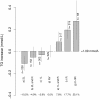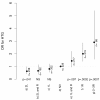Additive effects of LPL, APOA5 and APOE variant combinations on triglyceride levels and hypertriglyceridemia: results of the ICARIA genetic sub-study
- PMID: 20429872
- PMCID: PMC2877669
- DOI: 10.1186/1471-2350-11-66
Additive effects of LPL, APOA5 and APOE variant combinations on triglyceride levels and hypertriglyceridemia: results of the ICARIA genetic sub-study
Abstract
Background: Hypertriglyceridemia (HTG) is a well-established independent risk factor for cardiovascular disease and the influence of several genetic variants in genes related with triglyceride (TG) metabolism has been described, including LPL, APOA5 and APOE. The combined analysis of these polymorphisms could produce clinically meaningful complementary information.
Methods: A subgroup of the ICARIA study comprising 1825 Spanish subjects (80% men, mean age 36 years) was genotyped for the LPL-HindIII (rs320), S447X (rs328), D9N (rs1801177) and N291S (rs268) polymorphisms, the APOA5-S19W (rs3135506) and -1131T/C (rs662799) variants, and the APOE polymorphism (rs429358; rs7412) using PCR and restriction analysis and TaqMan assays. We used regression analyses to examine their combined effects on TG levels (with the log-transformed variable) and the association of variant combinations with TG levels and hypertriglyceridemia (TG > or = 1.69 mmol/L), including the covariates: gender, age, waist circumference, blood glucose, blood pressure, smoking and alcohol consumption.
Results: We found a significant lowering effect of the LPL-HindIII and S447X polymorphisms (p < 0.0001). In addition, the D9N, N291S, S19W and -1131T/C variants and the APOE-epsilon4 allele were significantly associated with an independent additive TG-raising effect (p < 0.05, p < 0.01, p < 0.001, p < 0.0001 and p < 0.001, respectively). Grouping individuals according to the presence of TG-lowering or TG-raising polymorphisms showed significant differences in TG levels (p < 0.0001), with the lowest levels exhibited by carriers of two lowering variants (10.2% reduction in TG geometric mean with respect to individuals who were homozygous for the frequent alleles of all the variants), and the highest levels in carriers of raising combinations (25.1% mean TG increase). Thus, carrying two lowering variants was protective against HTG (OR = 0.62; 95% CI, 0.39-0.98; p = 0.042) and having one single raising polymorphism (OR = 1.20; 95% CI, 1.39-2.87; p < 0.001) or more (2 or 3 raising variants; OR = 2.90; 95% CI, 1.56-5.41; p < 0.001) were associated with HTG.
Conclusion: Our results showed a significant independent additive effect on TG levels of the LPL polymorphisms HindIII, S447X, D9N and N291S; the S19W and -1131T/C variants of APOA5, and the epsilon4 allele of APOE in our study population. Moreover, some of the variant combinations studied were significantly associated with the absence or the presence of hypertriglyceridemia.
Figures


References
-
- Visvikis-Siest S, Marteau JB. Genetic variants predisposing to cardiovascular disease. Curr Opin Lipidol. 2006;17(2):139–51. doi: 10.1097/01.mol.0000217895.67444.de. - DOI - PubMed
-
- Sarwar N, Danesh J, Eiriksdottir G, Sigurdsson G, Wareham N, Bingham S, Boekholdt SM, Khaw KT, Gudnason V. Triglycerides and the risk of coronary heart disease: 10,158 incident cases among 262,525 participants in 29 Western prospective studies. Circulation. 2007;115(4):450–458. doi: 10.1161/CIRCULATIONAHA.106.637793. - DOI - PubMed
-
- Valdivielso P, Sanchez-Chaparro MA, Calvo-Bonacho E, Cabrera-Sierra M, Sainz-Gutierrez JC, Fernandez-Labandera C, Fernandez-Meseguer A, Quevedo-Aguado L, Moraga MR, Galvez-Moraleda A, Gonzalez-Quintela A, Roman-Garcia J. ICARIA (Ibermutuamur CArdiovascular RIsk Assesment) study group. Association of moderate and severe hypertriglyceridemia with obesity, diabetes mellitus and vascular disease in the Spanish working population: results of the ICARIA study. Atherosclerosis. 2009;207(2):573–578. doi: 10.1016/j.atherosclerosis.2009.05.024. - DOI - PubMed
-
- Morrison AC, Bare LA, Chambless LE, Ellis SG, Malloy M, Kane JP, Pankow JS, Devlin JJ, Willerson JT, Boerwinkle E. Prediction of coronary heart disease risk using a genetic risk score: the Atherosclerosis Risk in Communities Study. Am J Epidemiol. 2007;166(1):28–35. doi: 10.1093/aje/kwm060. - DOI - PubMed
Publication types
MeSH terms
Substances
LinkOut - more resources
Full Text Sources
Other Literature Sources
Medical
Miscellaneous

